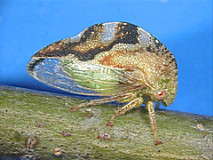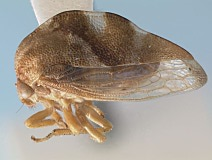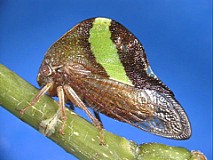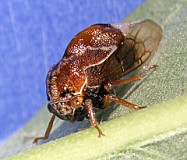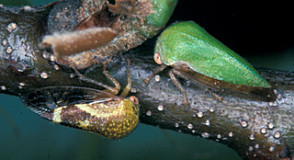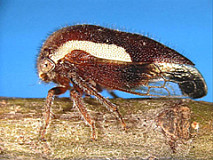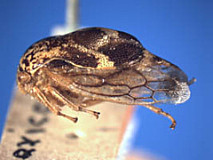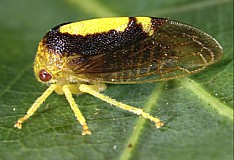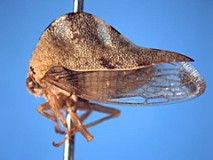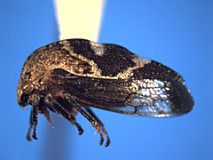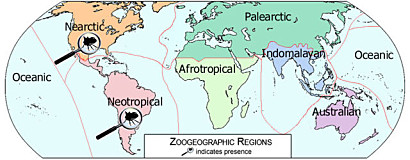Stål 1866a
Funkhouser 1927f
Funkhouser 1951a
Metcalf and Wade 1965a
Deitz 1975a
McKamey 1998a
Godoy, Miranda, and Nishida 2006a
Wallace 2010a
Wallace 2011a
Animalia → Arthropoda → Insecta → Pterygota → Hemiptera → Auchenorrhyncha → Cicadomorpha → Membracoidea → Membracidae → Smiliinae
Smiliini Stål, 1866
Selected references
Overview
A review of the Smiliini by Matthew S. Wallace (2011) changed the definition and taxonomic limits of this tribe. The group remains predominately North American in distribution and includes many species that feed on oaks (Quercus).
Taxon history
Goding (1892a) was first to recognize the tribe Smiliini, distinguishing it from Telamonini by the presence of crossvein r-m in the hindwing of members of the latter. Deitz (1975a), who considered Telamonini to be a junior synonym of Smiliini, included 22 genera in the latter tribe (Antianthe, Archasia, Ashmeadea, Atymna, Atymnina, Carynota, Cyrtolobus, Glossonotus, Godingia, Grandolobus, Heliria, Helonica, Hemicardiacus, Ophiderma, Palonica, Smilia, Telamona, Telamonanthe, Telonaca, Thelia, Tropidarnis,and Xantholobus). Deitz (1975) used the following combination of characters to define the Smiliini, sensu lato: Pronotum concealing much of forewing in repose, simple or modified with enlarged humeral angles (but without suprahumeral horns), elevated median carina, anterior or dorsal median horn, or longitudinal rugae. Forewing with veins R, M, and Cu separate near base, with 2 or more m-cu crossveins (exceptions: Smilia which has 1 m-cu crossvein). Hind wing either with r-m crossvein or with veins R4+5 and M 1+2 confluent for short distance and divergent more distally. Female second valvulae narrow and elongate, dorsal margin with 3 dorsal teeth.
Based on a phylogenetic analysis of morphological features, Wallace (2011a) redefined the tribe Smiliini to include only 9 genera (see " Taxonomic constituents," below), reinstated Telamonini as a valid tribe with 10 genera, and placed 4 genera (Antianthe, Hemicardiacus, Smilirhexia, and Tropidarnis) as incertae sedis within Smiliinae. Our taxon pages follow Wallace’s (2011a) revision in distinguishing the Smiliini and Telamonini (compare “Diagnostic characters” for each), but features to separate the latter tribe are not yet incorporated into his interactive key to the Nearctic tribes (Wallace 2010a).
Based on a phylogenetic analysis of morphological features, Wallace (2011a) redefined the tribe Smiliini to include only 9 genera (see " Taxonomic constituents," below), reinstated Telamonini as a valid tribe with 10 genera, and placed 4 genera (Antianthe, Hemicardiacus, Smilirhexia, and Tropidarnis) as incertae sedis within Smiliinae. Our taxon pages follow Wallace’s (2011a) revision in distinguishing the Smiliini and Telamonini (compare “Diagnostic characters” for each), but features to separate the latter tribe are not yet incorporated into his interactive key to the Nearctic tribes (Wallace 2010a).
Taxon images
Smiliini
5.
Ophiderma evelyna, female (gree...
↴
Acoustic calls
Distribution
Neotropical and Nearctic regions. Of nine included genera, Xantholobus, is endemic to the Nearctic region (United States and Canada), and Atymnina is endemic to Neotropical Mexico. The remaining genera occur in both the Neotropical and Nearctic regions.
Diagnostic characters
Head dorsal margin straight or very slight curved. Pronotum concealing much of forewing in repose, simple (lacking distinct median anterior projection, enlarged humeral angles, and longitudinal rugae), median carina complete (exception in Ophiderma). Forewing with veins R, M, and Cu separate near base, not crowded anteriorly (separated by large cells); vein R4+5 confluent with M basad of M fork; with 2 or more m-cu crossveins (exceptions: Smilia which has 1 m-cu crossvein). Hind wing with veins R4+5 and M 1+2 confluent for great distance (exception: these veins free in some tropical specimens). Female second valvulae narrow and elongate, dorsal margin with 3 large teeth (second tooth closest to third) and smaller teeth distally; dorsal and ventral margins converging distally; apex rounded. Length of female usually less than 8 mm (exceptions: Grandolobus, Godingia, Smilia, and some Cyrtolobus spp.).
Taxonomic constituents
Ashmeadea Goding, 1892 Goding, 1892
Atymna Stål, 1867 Stål, 1867
Atymnina Plummer, 1938 Plummer, 1938
Cyrtolobus Goding, 1892 Goding, 1892
Godingia Fowler, 1896 Fowler, 1896
Grandolobus Ball, 1932 Ball, 1932
Ophiderma Fairmaire, 1846 Fairmaire, 1846
Smilia Germar, 1833 Germar, 1833
Xantholobus Van Duzee, 1908 Van Duzee, 1908
Prepared by
Matthew S. Wallace, Lewis L. Deitz, Mark J. Rothschild, and Stuart McKamey, 2 November 2014.


